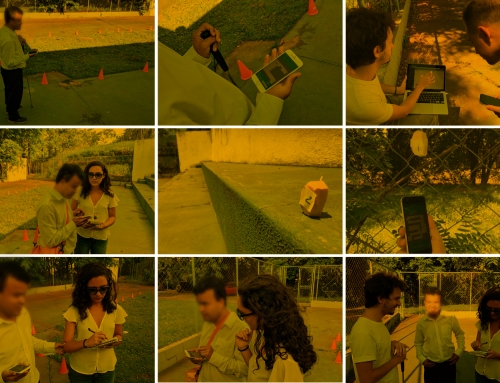ELIA is a breakthrough new language for the blind that can be mastered in a matter of hours, not months.
Almost 200 years ago, a blind, 20-year-old French student demonstrated a dot-based reading-and-writing system at the 1834 Paris Industrial Exposition that would go on to become the single, universal standard for the visually impaired. Louis Braille, who lost his eyesight at age three from a freak accident while playing with his father’s leather-making knife tool, was inspired by a covert “night writing” code alphabet used by Napoleon’s army. Endorsed by UNESCO in the 1950s, it’s been adapted to 133 languages and spawned special Braille codes for music, science, and math notations. With growing awareness for accessible design, these embossed dots are everywhere: building signs, elevator buttons, new banknotes, even medicine packaging in Europe.
In its heyday, the blind community championed Braille as the key to independence, literacy, and employment. The problem is that only a very small fraction of blind people actually read Braille today. In the U.S., less than 10% (around 60,000 people) of the estimated 8 million blind population use it regularly. That’s a steep decline from the 1960s, when more than half the country’s blind population read Braille.
If you didn’t learn Braille as a child, the prospect of learning the system of cells and codes sounds daunting, requiring about six to nine months of intense study and memorization. With advanced text-to-speech technology and smartphone apps like TapSeeTap, which recognizes objects based on photos, or LokTell which helps blind users sort banknotes, experts fear that Braille may soon join Esperanto in the annals of dead languages.
This alarming disparity struck Andrew Chepaitis, a former equity research analyst who founded a startup called ELIA Life Technology. ELIA, which stands for Education, Literacy, and Independence for All, aspires to challenge Braille’s dominance through an easy-to-learn system based on letterforms of the Roman alphabet.

ELIA Frames, image courtesy of ELIA
After years of development, ELIA’s marquee project, ELIA Frames, is finally ready. Distributed as a free-to-download font on its website, ELIA Frames will be spotlighted in the Cooper Hewitt, Smithsonian Design Museum’s exhibition, “The Senses: Design Beyond Vision.” Chepaitis is also launching a Kickstarter campaign to introduce ELIA Frames to “a community of early adopters, innovators, and creative thinkers,” as he puts it.
For time-strapped adult learners, ELIA Frames offers a compelling proposition: Instead of months memorizing dot patterns and permutations, Chepaitis suggests that users can gain mastery of the Roman alphabet-based system in a matter of hours.
ELIA’s system is based on a series of strokes and dots contained in four distinct shapes. Letters A-D are contained in a semi-circle; O-S are in a circle; and the rest of the letters are boxed in a square frame. Numerals are contained in a pentagon that looks like a house. Refined with the input of some 200,000 test participants, ELIA’s designers believe that the shapes that evoke letterforms from the Roman alphabet help distinguish characters.
“A family, classroom, or an office can learn it in five minutes and then incorporate it into their daily lives,” asserts Chepaitis, who got the initial idea for ELIA Frames from his mother’s PhD research. Because it’s so easy to learn, he’s hoping that ELIA will offer a common alphabet for all readers. “[Companies] may prefer ELIA, because all their employees could learn it during lunch one day and then share a common alphabet with their blind and low-vision employees,” he explains.

ELIA Frames, image courtesy of ELIA
ELIA already has a strong list of backers: It’s raised $450,000 in seed investments and $2.7 million in grants from the National Institute on Aging, the National Eye Institute, the National Institute for Standards and Technology, and NYSTAR. It’s also partnered with Hewlett-Packard to develop a desktop inkjet printer that will allow users to instantly produce tactile fonts and graphics.
Chepaitis envisions that ELIA might attract more investment in assistive technology in general. “People have looked at our market as unattractive because of Braille’s performance, and that gave us time. Who would invest $3 million in a market where the standard has 59,000 potential customers?,” he says. “Braille is, in many ways, is still tied to the mechanical systems of the 19th and 20th centuries.”
ELIA, on the other hand, wants to position itself as the Apple of assistive languages: Friendly, easy-to-learn, and intuitive. It’s even cleaned up its branding and website with the help of Order, a graphic design studio founded by former Pentagram designers Jesse Reed and Hamish Smyth.

ELIA Frames, image courtesy of ELIA
But not everyone is completely sold on the Braille alternative, as Fast Company reports. The U.S. National Federation of the Blind (NFB) says ELIA Frames will slow readers down because they’ll have to trace around each frame with their finger. “You are never going to build up the kind of reading speed and fluency that you would want,” says NFB spokesperson Chris Danielson. “This idea that Braille is hard to learn, we would argue that’s a self-fulfilling prophecy.”
Chepaitis is hopeful that NFB might warm up to ELIA one day, but for now, he’s not letting its reservations deter his momentum. “We respect their opposition and criticisms of our work. This is a field where a lot is at stake. People’s independence, educations, literacy, and ability to work—those may be affected by our work, especially if we fail. The onus is on us to demonstrate that we can do good. If we do that, perhaps they will collaborate with us,” he says.
Chepaitis says he’s less concerned with replacing Braille altogether as he is with offering a faster, more accessible alternative for 90% of the blind population. “We are focused on helping people achieve greater independence and literacy,” he says. “It’s been really challenging. But I’ve had faith that this initiative is the most worthwhile way I could spend each day.”
This post was originally published on 99U.



